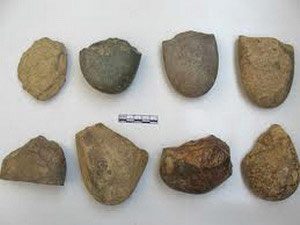Head of the Science Department (Vietnam Archaeology Institute), Associate Professor Dr. Trình Năng Chung, stated that during a recent excavation in Vật Lại and Phú Sơn communes, Ba Vì district, Hanoi, the research team discovered two archaeological sites containing artifacts from prehistoric humans.
The two sites are Cống Chuốc Hill (Vật Lại commune) and Lương Tụ Hill (Phú Sơn commune), located on elevated hills ranging from 20 to 30 meters high, which are remnants of the ancient second terrace of the Da River.
The research team found dozens of stone tools used by prehistoric humans, including pointed tools for digging and primitive cutting tools such as knives and scrapers. All of these artifacts were crafted from river pebbles using very rudimentary stone-working techniques.

Stone tools used by prehistoric humans. (Illustrative image. Source: Internet)
Notably, the team discovered many stone flakes and unfinished tool prototypes. These findings are significant evidence that prehistoric humans crafted tools on-site.
Although no signs of housing or cooking areas have been found, archaeologists believe these sites were habitation areas of prehistoric humans on the surfaces of ancient river terraces.
According to Dr. Chung, the characteristics of the distribution of these sites and artifacts, along with the techniques and types of tools, closely resemble those from the Sơn Vi culture, which is widely distributed in the hilly regions of Phú Thọ, Yên Bái, Bắc Giang, and Lào Cai.
Based on the distribution characteristics and comparisons with other significant prehistoric cultures in the region, archaeologists have dated the two newly discovered sites in Ba Vì, Hanoi, to the Upper Paleolithic period in Vietnam.
There is substantial evidence indicating that the prehistoric inhabitants of Ba Vì had close relationships with contemporary residents in the neighboring Phú Thọ area, belonging to the developed Sơn Vi culture, which dates back approximately 15,000 to 20,000 years ago.




















































